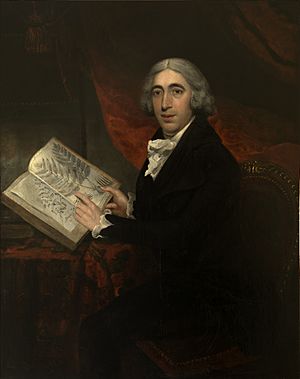James Edward Smith (botanist) facts for kids
Quick facts for kids
Sir James Edward Smith
|
|
|---|---|

Portrait of Sir James Edward Smith
|
|
| Born | 2 December 1759 Norwich, England
|
| Died | 17 March 1828 (aged 68) Norwich, England
|
| Nationality | English |
| Alma mater | University of Edinburgh |
| Scientific career | |
| Fields | |
| Institutions | Royal Swedish Academy of Sciences |
| Academic advisors | Joseph Black John Walker |
| Author abbrev. (botany) | Sm. |
Sir James Edward Smith (born December 2, 1759 – died March 17, 1828) was a famous English scientist who studied plants. He is best known for starting the Linnean Society, a very important group for natural history.
Contents
Early Life and Learning
Smith was born in Norwich, England, in 1759. His father was a rich wool merchant. From a young age, James loved learning about nature.
In the early 1780s, he went to the University of Edinburgh to study medicine. There, he learned about chemistry from Joseph Black. He also studied natural history, which is the study of plants, animals, and rocks, with John Walker.
In 1783, Smith moved to London to continue his studies. He became friends with Sir Joseph Banks, another important botanist. A famous Swedish scientist named Carl Linnaeus had a huge collection of books, notes, and plant samples. After Linnaeus's son died, this collection was offered to Joseph Banks.
Banks decided not to buy it, but Smith did! He bought the entire collection for a great price of £1,000. The collection arrived in London in 1784. In 1785, Smith became a member of the Royal Society, a group for top scientists.
A Career in Botany
Between 1786 and 1788, Smith went on a big trip across Europe. He visited countries like the Netherlands, France, Italy, and Switzerland. On his journey, he met other plant scientists. He also visited art galleries and herbaria, which are collections of dried plants.
In 1788, he started the Linnean Society of London. This society was named after Carl Linnaeus. Smith became its first President and stayed in that role until he died.
In 1796, he moved back to Norwich. He brought the entire Linnaeus Collection with him. His library and plant collections became very famous in Europe. Many scientists who studied insects (entomologists) and plants (botanists) came to visit him. In 1792, he was chosen as a foreign member of the Royal Swedish Academy of Sciences. He also became a member of the American Philosophical Society in 1796.
Smith spent the last 30 years of his life writing many books and articles about plants. Some of his famous books include Flora Britannica and The English Flora. He wrote 3,348 articles about plants for a large encyclopedia called Rees's Cyclopædia. He also wrote 57 life stories of other botanists.
Smith worked on Flora Graeca, a major book about plants from Greece. He also worked with an artist named James Sowerby. Smith described the plants, and Sowerby drew them. They became very interested in mosses and lichens together.
In 1797, Smith published The Natural History of the Rarer Lepidopterous Insects of Georgia. This was one of the first books about insects in North America. It included drawings and notes from John Abbot. Smith used Abbot's drawings to describe new insect species.
Smith was good friends with William Roscoe. He even named a plant group, Roscoea, after him. Between 1806 and 1817, Smith added 5,000 plants to the Roylean Herbarium. This collection later became the Smith Herbarium at the Liverpool Botanical Garden.
Later Life and Passing
Sir James Edward Smith passed away at his home in Norwich on March 17, 1828. He was 68 years old. After he died, the Linnean Society bought his own plant collections and the Linnaeus Collection for £3,000.
He was married to Pleasance Reeve. She lived for 49 years after him. She also put together his memories and letters into a book. They are buried together in Lowestoft. His niece, Frances Catherine Barnard, was also a writer.
Important Works
- Icones pictae plantarum rariorum descriptionibus et observationibus illustratae. London, 1790–93.
- A dissertation on the sexes of plants (1786). This was a translation of a Latin book by Linnaeus.
- "Tentamen Botanicum de Filicum Generibus Dorsiferarum" (1793). This was one of the first scientific papers about how to group ferns.
- English Botany: Or, Coloured Figures of British Plants (1813). Smith wrote the descriptions for this huge work. It had 36 volumes with 2,592 hand-colored pictures of British plants. James Sowerby published and illustrated it.
- Lachesis Lapponica or A Tour in Lapland (1811). This was a translation of Carl Linnaeus's travel notes.
- Tracts Relating to Natural History (1798). This book was a collection of essays about Linnaeus and plants.
Named After Him
The Himalayan spruce tree, called Picea smithiana, is named in honor of Sir James Edward Smith.
See Also
 In Spanish: James Edward Smith para niños
In Spanish: James Edward Smith para niños
- Category:Taxa named by James Edward Smith

